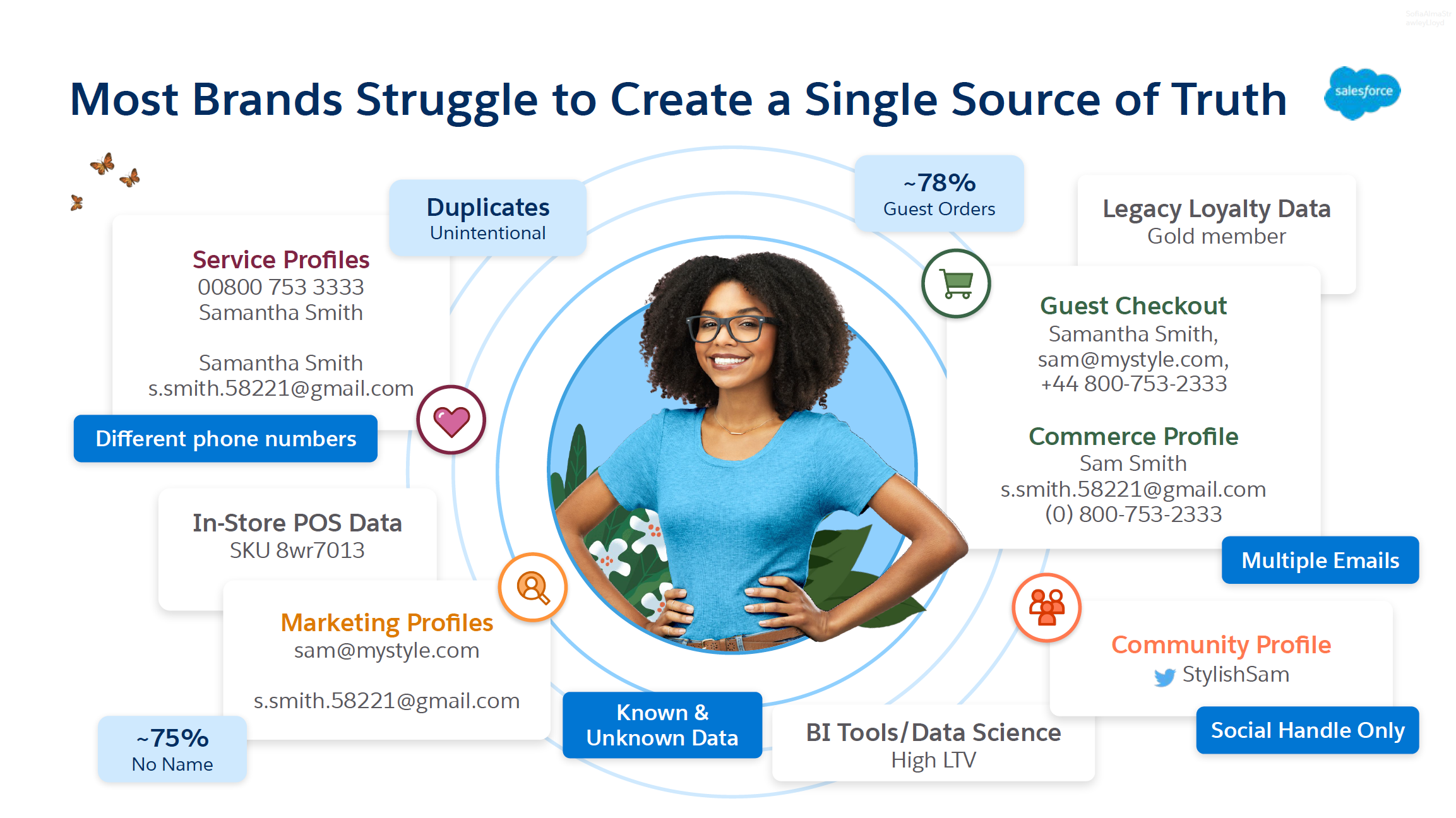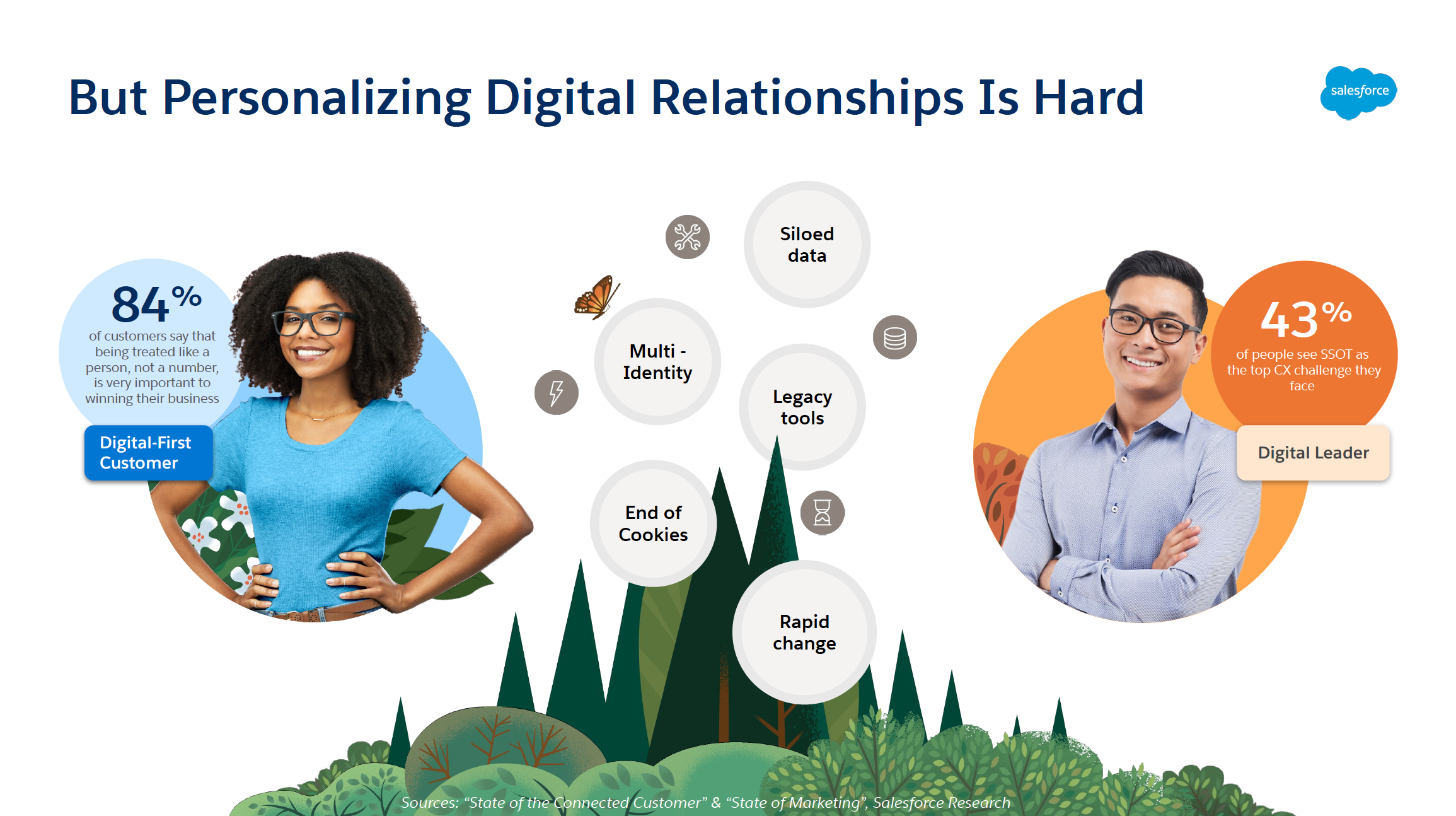Single source of truth (SSOT) is a buzzword that crops up in many Salesforce presentations. This is the “holy grail” of data strategy, single source of truth gives you one view of each person, unifying their data across all of your databases. This means that there is no conflicting data (i.e. different data in multiple systems for the same data point) and therefore, everyone in the organization is using the same data to make decisions.
Knowing where to start is difficult. There are an infinite number of factors influencing how fast you can reach a more cohesive database – and whether it’s possible for your organization altogether! There is no “one size fits all” approach – and certainly not something I can outline in one article.
This is not going to be a “how-to” guide. Instead, I thought it would be beneficial to outline common challenges, so that you may be able to identify them in your own organization.
These are my takeaways from “Leverage your Marketing Data with a Single Source of Truth”, a Circle of Success session at the Connections ’22 event. These peer-to-peer group discussions are my favorite sessions to attend; everyone at the table has a chance to discuss how they use Salesforce product/s, and hear from other Salesforce customers to get ideas or solve challenges.
What Is “Single Source of Truth”?
Single source of truth gives you one view of each person, unifying their data across all of your databases, which results in:
- No conflicting data, i.e. different data in multiple systems for the same data point, for example, a contact’s address in Salesforce vs their address in a membership platform.
- “Identity resolution”, i.e. piecing together who the person is, regardless of which unique identifier you’re using in each database, for example, you have the contact’s name in Salesforce but they use a social handle/username on social media which makes it hard to match their social media activity to their contact record.
60% of people ranked SSOT as the most important digital capability for their organization.
– Salesforce Future of Digital Customer report.
Personalizing digital relationships is hard. I don’t want to state the obvious but we’re all thinking it. Take a look at how disparate a customer’s data could be:
Single Source of Truth Obstacles
The challenges facing marketers include siloed data, multi-identity, legacy tools, the end of cookies, and rapid change making it harder to implement and maintain data strategies harder.
What do these actually boil down to?
1. Users not inputting data
The age-old challenge of getting users to update Salesforce is a ceaseless complaint from system admins.
Salesforce has developed a – perhaps unfair – reputation, with some suggesting that it is ‘clunky’ to update, with countless clicks, multiple tabs, and page load lag time.
There are multiple ways to solve this. You may find you’re successful with using:
- Record Types to limit the number of fields to only relevant fields.
- Dynamic Forms to show certain fields according to the stage/status the record is in.
- Quick Actions to show relevant fields that need completing.
- URL hacking to pre-populate information based on related records.
- Third-party tools, such as “revenue workspaces” that give users a more familiar note-taking interface, and more.
2. Data completedness
Similar to the first point, missing data puts a wedge between achieving a single source of truth. You need data to resolve identities – in other words, have enough information to ascertain whether one person’s record should be matched with another record that also represents them.
While the suggestions in point #1 apply here too, you can tap into data enrichment tools to fill the gaps. Figure out the state of your data completedness (such as field population, the % of records with a specific field filled in) using Salesforce Optimizer (free) or third-party tools (that have more capabilities to help you take action on your findings).
Above: Findings in a Salesforce Optimizer report.
3. Duplicate data
Duplicates and de-duplication are my least favorite topics to discuss. Nevertheless, it’s an unavoidable truth that duplicate data will way its way into your organization.
One example that came up was in healthcare. In the US, NPI (National Provider Identifier) numbers identify an individual provider or a healthcare entity, used by all employees. While I’m not clued up on the details, there’s an added layer of complication to this use case that troubles those marketing to healthcare entities.
It’s hard to pin down “hard and fast” rules on how you want to de-duplicate. Which is the winning record that should trump over the other duplicates? This question then extends down to a per-field basis. Are you determining the winning data by when it was created, last modified, or whether a user or system updated the information? De-duplicating data quickly becomes a nightmare.
Salesforce Marketing Cloud is not an ETL tool, so doing de-duplication heavy lifting is near impossible.
Then there’s fuzzy matching, which will return a match when two fields are alike (similar) versus an exact match. It’s like looking through almost closed eyelids, with your vision becoming fuzzy and it’s hard to distinguish small differences between words. For example, someone could be named Samatha Smith in one place but Sam Smith in another – are they the same person?
4. No foreign key
“A foreign key is a common link found between data sources that builds data relationships—for example, a customer ID number.” – Trailhead.
5. Lack of strategies for the cookieless future
Record completedness is going to stand in your way but the impacts of the cookieless future are out of your control.
Without cookies, tracking consumer behavior is more challenging, leaving gaps in how much you know about the consumer. In turn, this will impact the completeness of the view you have of each individual, requiring you to adapt how you map data during identity resolution setup.
This plan outlined on Advertising Week will give you insight into tactics you could change to alleviate the impact.
6. Technology cost
When cleaning data and resolve identities at scale, you need some tech to connect, automate and maintain databases. Unfortunately, that comes at a cost that’s not workable for some organizations.
How Marketing Cloud CDP Works
Marketing Cloud CDP enables you to “connect the dots” by resolving identities i.e. piecing together who the person is, regardless of which unique identifier you’re using in each database. For example, you have the contact’s name in Salesforce but they use a social handle/username on social media which makes it hard to match their social media activity to their contact record.
I liked how Marketing Cloud CDP was described as giving you some “horsepower”. A couple of key takeaways I had are:
- The process of setting up CDP rulesets is similar to defining duplicate rules (and match rules) in Salesforce.
- Beyond standard deduplication, you’re pulling in data sources beyond Salesforce (known as data streams). Amazon S3 buckets are leveraged to get data in from other sources. There’s also an API route (BULK or streaming API).
- Segments generated can be used in Marketing Cloud, e.g. Journey Builder.
There are plenty of resources on Trailhead that go into the details of why CDPs are used, the terminology involved, and how Marketing Cloud CDP works. Rather than reinventing the wheel, follow these trails instead:
- Customer Data Platform Basics: What it is, why it’s important, and preparing for implementation.
- Data and Identity in Customer Data Platform: Goes into how Marketing Cloud CDP actually works, including the purposes of the Individual object, contact point object and party identifier object.
Above: How data mapping looks during Marketing Cloud CDP setup.
Above: An Identity Resolution Ruleset, including Party Identifiers and fuzzy matches.
Summary
Knowing where to start building up a single source of truth, unifying information from all of your databases, is difficult. This wasn’t a “how-to” guide, but outlined common challenges, so that you may be able to identify them in your own organization. Now, dive deeper into the Trailhead resources on how CDP works (and hopefully, you’ll be able to find the budget for it!)




